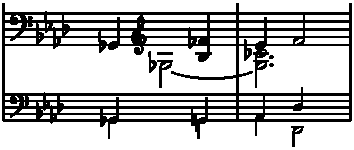



Issues : Accompaniment changes
|
b. 232-235
|
composition: Op. 44, Polonaise in F♯ minor
..
In AImaz the R.H. part includes only the top voice melody; moreover, it differs from the final version in two places:
There are also minor rhythmic differences – see b. 220-242. category imprint: Corrections & alterations; Source & stylistic information issues: Accompaniment changes , Main-line changes |
||||||||
|
b. 232-235
|
composition: Op. 44, Polonaise in F♯ minor
..
In AImaz the form of the accompaniment is much simpler. In b. 232-233 it consists of two crotchets (bass and chord) and rests. In b. 234-235 there are crotchets only following the bass-chord-chord scheme, whereby both bars are almost exclusively based on a B major chord (it is only on the 3rd beat of b. 234 that an E major chord appears). category imprint: Corrections & alterations; Source & stylistic information issues: Accompaniment changes |
||||||||
|
b. 243-244
|
composition: Op. 21, Concerto in F minor, Mvt III
..
There is an evident non-compliance of the part of the L.H. in A with the cello and double bass sequence in Morch within ½A: category imprint: Differences between sources; Corrections & alterations issues: Accompaniment changes , Authentic corrections of FE , Authentic corrections of GE |
||||||||
|
b. 247
|
composition: Op. 19, Bolero
..
It is difficult to unequivocally prove where the difference between the pitch of the 3rd quaver in the accompaniment in FE (→EE) and GE came from. Both sources do not reveal any explicit traces of corrections. We assume that it is most likely that Chopin corrected the original (perhaps even erroneous) version of FE in GE. However, the evidence is inconclusive, hence we add a variant of the base source, FE, to the main text. category imprint: Differences between sources; Corrections & alterations |
||||||||
|
b. 260
|
composition: Op. 2, Variations, complete
..
Chopin added the octave bass sequence in the 2nd half of the bar while proofreading FE1. This addition, undoubtedly drawn from FE, was also introduced into EE3. According to us, it is likely that the composer wanted this unquestionable improvement of the version for one piano to apply to the version of the piece with orchestra too (as a complement to the cellos and the double basses). A few years later, also exclusively in the version for one piano, Chopin introduced a change into the first tutti in mov. III of the Concerto in F minor, Op. 21. It is also there that we can assume that the changed text was supposed to concern the orchestral part also in the full version of the piece. category imprint: Differences between sources; Corrections & alterations issues: Accompaniment changes , Authentic corrections of FE , Authentic post-publication changes and variants |

 1, while in the final version – b1;
1, while in the final version – b1;
 in
in 

 .
.
